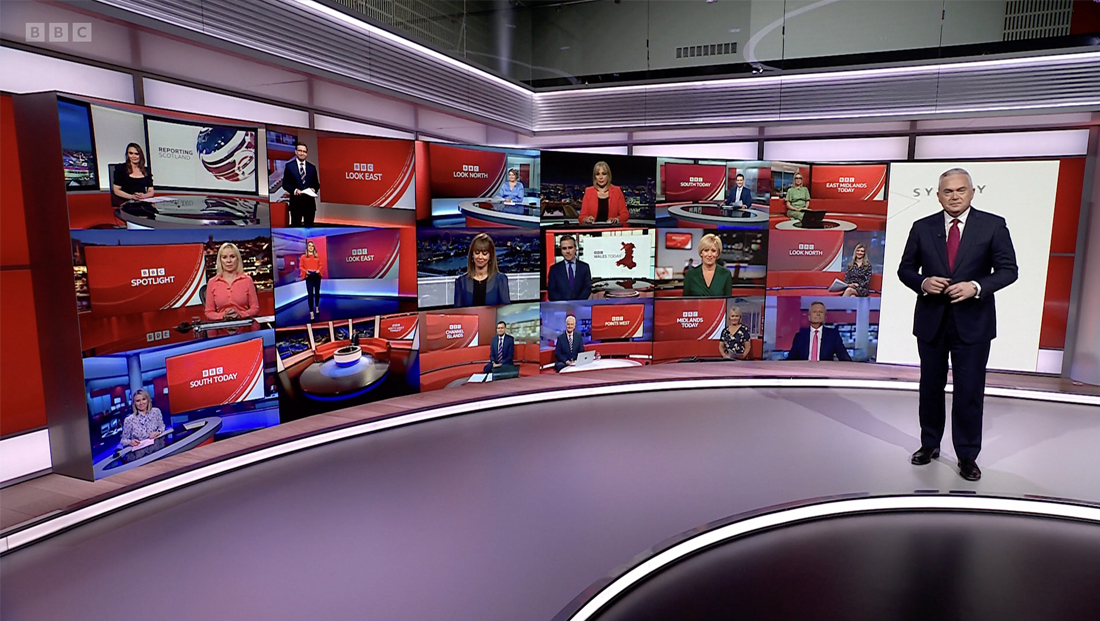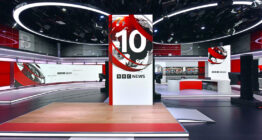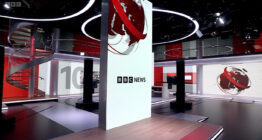How BBC News creates that live 18-box preview of its regional centers

Subscribe to NCS for the latest news, project case studies and product announcements in broadcast technology, creative design and engineering delivered to your inbox.
As impressive as the new set for BBC One’s 6 and 10 p.m. newscasts’ use of LED video walls is, it’s one particular use of those panels that is making perhaps even a bigger splash in the TV news industry.
The new set, which is in Studio B inside of Broadcasting House, features a myriad of seamless LED video walls, including a large curved array with what the channel calls a “catwalk” — a raised platform meant for presenters to stand on — in front of it.


Toward the end of the newscast, anchor Huw Edwards walks over to that area from the anchor desk. The video wall animates and reveals an impressive 18-box layout showing live feeds from each of BBC’s regional centers as they prepare to take over the BBC One feed for localized news updates.
A BBC lead news director named David Croxson noted on Twitter that “those are genuinely live feeds from all of the BBC’s teams across the U.K.”
Fun fact about the new hand to nations and regions at the end of the Six and Ten – those are genuinely live feeds from all the BBC’s teams across the UK
— David Croxson (@deejaycrox) June 15, 2022
Chris Cook, who is creative director for output operations, concurred and also gave some more detail about how the effect is achieved from a technical standpoint.
Even bigger fun fact – it’s 2 black magic boxes creating 2x 9 ways that appear in the gallery as 2 Outside Sources – our amazing colleagues in Master Control Room are in charge of who appears where… #CelebritySquares pic.twitter.com/CqYsnpmjqx
— Chris Cook (@chrisckmedia) June 15, 2022
According to Cook, who also included a photo of from the control room, or gallery, as it is often referred to outside the U.S., there are multiple layers combined to create the video wall look.
Using hardware from Blackmagic, BBC creates two 3×3 feeds (nine boxes on each) that appear to the gallery crew as two external feeds, for a total of 18 boxes.
This is then combined side-by-side along with a vertical white graphic on the far right behind where Edwards stands, to create the look of a single graphic, with Vizrt compiling everything into a single, distinct image.
An 18-box is nowhere near what some stations have done to showcase team coverage during major events, such as Atlanta station WSB’s 25-box during a freak winter storm.
However, in many cases, these large box arrays don’t actually include all or any live feeds of talent.
Instead, they may be created using a combination of live and taped clips of reporters and anchors looking into the camera from the studio or field.
The recordings are typically captured shortly before air and then either inserted into the graphic on the fly or baked in so that it entire look becomes a single source stored in playback, almost as if it were SOT or a package.
There are several reasons for this. First, most stations and even networks couldn’t easily handle taking in 25 live feeds at once and then combining them into a single screen.
It also poses the challenge of getting multiple people in multiple locations to all look at the camera for what typically amounts to a few seconds at the exact same time, something that can be challenging given how finicky IFBs and intercom technology can be.
Can't wait too see this a lot haha pic.twitter.com/EGihg5FU7u
— Everything Favourites (@EverythingFavs) June 14, 2022
BBC appears to have developed a workaround for the technical limitations — and given that its headquarters routinely monitors all of the regional outputs and may even be involved in handling the feeds themselves, it already has all 18 of those sources coming into the building live.
In addition, because the 18-box is shown just before each of the regional centers take over, all talent would be likely to be on set and ready to go on air anyway and may already be staring into the camera because they hit air in just moments.
It’s worth noting that Cook’s tweet appears to show the feeds ahead of when they actually hit air because at least one shot shows bars and there are also some where presenters aren’t on set yet. The ones who are on camera appear in varying states of readiness, including one who appears to be seated on a sofa leaning over a laptop.
There has already been one instance of the toss sequence not being quite ready — though it involved the live “Newsnight” preview that comes just before the 18-box layout.
It appears the “Newsnight” team didn’t realize its output was being used over on BBC One, with the camera shown zooming in and out wildly, presumably checking focus before airtime. Edwards noted that the camera needed to “settle down.”
Can't wait too see this a lot haha pic.twitter.com/EGihg5FU7u
— Everything Favourites (@EverythingFavs) June 14, 2022
“Newsnight” airs on BBC Two but typically originates from the same building as the 6 and 10 p.m. news.
Subscribe to NCS for the latest news, project case studies and product announcements in broadcast technology, creative design and engineering delivered to your inbox.







tags
BBC, BBC News, Blackmagic Design, Broadcasting House, studio b, Video Walls, Vizrt
categories
Broadcast Engineering, Broadcast Industry News, Featured, Network Newscast, Networks